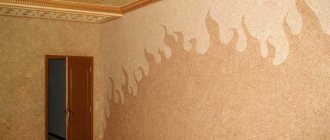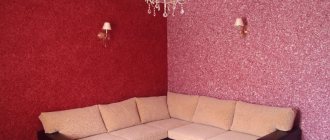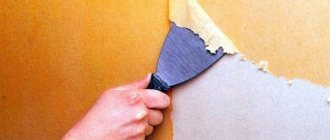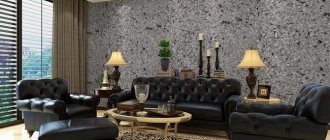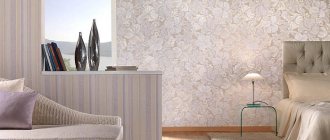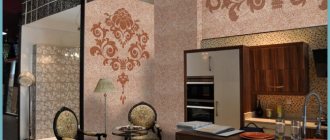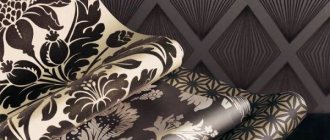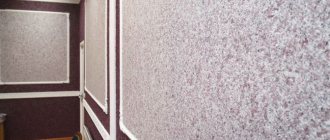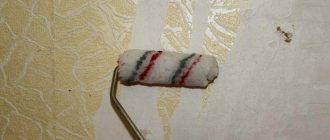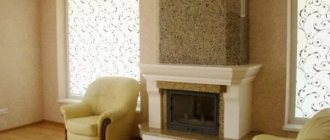What prerequisites precede the application technology?
The technology is the same as when applying decorative plaster, but differs in that the surface must be perfectly flat, smooth, without dents, scratches, or residues of other paint. The high absorbency of the material requires careful preparation of any walls in the room. Additional work is carried out before applying a layer of adhesive mass.
Liquid wallpaper on the wall
It can be conditionally accepted that the finishing material serves as a kind of indicator. It will show how correctly and efficiently repairs are carried out in an apartment, house, or office. If you do not comply with the technical conditions and deviate from the technology for carrying out repair work, then all the flaws in the finishing will immediately show up on the walls with the mixture applied to them.
Preparing the concrete surface
Everything will depend on the condition of this surface. If this is a wall in a new building apartment, then you can immediately begin leveling it. And although it was already noted above that liquid wallpaper is a leveling material, it still will not cover large wall defects.
Therefore, here is the sequence of work carried out:
- Apply a layer of deep penetration primer with your own hands. It will ensure the bonding of the leveling layer to the concrete wall and strengthen the top layer of the wall (see video).
- After the primer has dried (this usually takes 6-8 hours), a putty layer is applied, which will cover and fill all the flaws in the wall and level it (see video). The putty usually dries within 24 hours.
- Wall surfaces are painted with white water-based paint. It is applied in three layers, as they say, wet. That is, there is no need to wait for the first layers to dry.
Attention! The paint is applied in a cross pattern. This is when, for example, the first and third applications are laid horizontally, and the second vertically. It can be applied vice versa. There is no difference here.
General rules to follow
When applying wallpaper, it is recommended to follow the general rules - regardless of what material the surface is made of.
The preparation rules are as follows:
- before starting work, you must carefully remove the old wallpaper, its remains, and paint (they will show through the wallpaper, and then the work will have to be redone due to the spoiled appearance of the coating);
- then all screws and nails are removed, leaving only those that are needed;
- the wall is protected and treated with a special primer mixture;
- after drying, the surface is painted white. This procedure is carried out several times, which helps to achieve a smooth effect. Do not use oil or nitro paints, as they are environmentally hazardous and do not allow coatings to breathe;
- Do not use water-based paint, especially if rust from the nails remains. The paint will turn yellow and the stain will appear during application and drying of the liquid wallpaper;
- PVA glue, which is added to the paint, serves as a means of adhesion of liquid wallpaper to the painted wall.
Application of liquid wallpaper
When preparing to apply wallpaper, you must follow the instructions: pour warm water into a plastic container, gently shake the bag with the mixture inside, pour it into the container, mix thoroughly with your hands and leave to swell for 12 hours. The mixture can be used within 2 weeks after mixing.
Results
Before deciding to paint liquid wallpaper, it is recommended to first weigh the pros and cons. The process itself is quite easy and will not put a dent in your pocket. But experts do not always dare to answer in the affirmative the question of whether it is possible to paint liquid wallpaper. The main thing is to carry out repairs carefully so as not to damage the structure and ensure high quality of the work done. We review the result that can be obtained after painting the wallpaper in this video:
Liquid wallpaper today is often used as a finishing material for walls and ceilings in a house or apartment. This is a dry mixture, which is diluted with a certain volume of water before use. Using this finishing material, you can decorate surfaces with unevenness and flaws.
When the walls and ceiling are covered with liquid wallpaper for the first time, any color of the finishing material is chosen. It is selected to match the furniture, equipment, and style of the room. But over time, the richness of the paint is lost, and the surface loses its attractiveness. The answer to the question is it possible to paint liquid wallpaper will help you understand how to solve the problem.
Additional materials
On the building materials market there is a special primer mixture designed to work with various surfaces and is ideal for applying liquid wallpaper to it. This is a colorless or white primer and concrete contact. If the surface is too smooth, then use a priming mixture containing quartz dust. In this case, roughness will appear on the wall, which will provide a high level of adhesion. You can achieve this effect yourself by adding quartz dust and clean, fine-structured sand to the primer mixture.
It may happen that the wall surface was stained with grease. Oily stains will leave obvious marks on liquid wallpaper. Before general treatment, it is necessary to degrease the stain itself and the area around it. This can be done with a special mixture for removing silicone, which is sold at any auto store. If it is not on sale, then solvent No. 646, gasoline, will do. Grease stains are scraped off with a spatula, the surface is sanded and degreased. Dry before applying other materials.
If there are cracks in the walls, they can be eliminated (sewn up) with a special mesh - serpyanka. It is placed on tile adhesive or repair compound. First, the crack is widened, then fixed. If it is large, then you can fill it with polyurethane foam using a gun and clean it.
If the room was previously painted, then the walls must be cleaned. Water-based paint is easily washed off with water, oil-based paint can be removed with a hair dryer. Under the influence of a hot air stream, the surface heats up and the paint is removed with a spatula. You can use a sander and a wire brush. Special solutions are used in extremely rare cases when the above methods do not help.
Disadvantages of painting
With all the advantages of this option, the disadvantages should also be taken into account when choosing. These include the presence of such factors:
- liquid wallpaper creates a very soft, silky coating on the wall. If you paint it, the original features of the wallpaper will disappear, and no patterns or other decorations will be visible. The wall will become solid and monochromatic;
- this material has become widely known due to the fact that it can be easily removed from the wall, diluted with water and reapplied. After treatment with paint, this will no longer be possible;
- painting can lead to destruction of the surface structure, since liquid wallpaper actively absorbs water. Therefore, when working, you should be as careful as possible and follow the instructions.
Walls of various types and preparation features
Various surfaces made of concrete, plasterboard, wood, concrete blocks and similar materials have their own specific characteristics, which must be taken into account when applying liquid wallpaper. The structure of materials reacts differently to coating. Some of them easily absorb the mixture, while others require an additional primer. Taking into account the surface features allows you to achieve high-quality results. You can do this yourself. In any case, you must have interior finishing skills. Otherwise, everything will have to be redone, which will entail significant costs.
Is this possible and is it even worth it?
During the use of liquid wallpaper, especially if there are children in the apartment, the walls become dirty: hard-to-remove stains, scuffs, and general dirtiness appear. In addition, in places where sunlight falls, they fade a little (fade). Plus, over time, the same decoration begins to depress psychologically. Therefore, I want the interior to be updated and new. Another option is painting the walls. Is it possible to paint liquid wallpaper? The short answer is yes. In two ways:
- remove the liquid wallpaper from the wall with a spatula, soak it and re-tint it, then apply it to the wall again (the possibility of reuse is the main feature of this type of finishing material). How to properly perform such work at home can be read in the material “How to make liquid wallpaper with your own hands?”;
- paint the wall.
In the latter case, the question arises, what kind of paint can be used to paint liquid wallpaper?
Drywall and concrete - high absorbency guaranteed
Let's start describing the process with the simplest surface - drywall. It is believed that such a wall is already covered with white paint, and no additional processing is necessary. This is the first mistake. Plasterboard material guarantees a high degree of absorption due to its structure, so it is best to process it additionally than to waste expensive materials in double or triple amounts. It is important to consider the processing of joints and fasteners.
Smoothing liquid wallpaper over the wall
The ideal option is galvanized self-tapping screws. They do not rust when in contact with liquid, and yellow spots will not appear. If installation has already been carried out, then the self-tapping screws should be recessed properly, treat the fastening points with oil paint, apply another layer of putty and let dry. In cases of leakage or swelling of the surface, it is thoroughly cleaned, rubbed, covered with copper sulfate or oil-based paint, onto which another paint is applied. Then you can avoid dark spots.
The concrete structure has a high level of porosity, despite the fact that it may be made of high quality material. Preparing walls for liquid wallpaper on a concrete surface involves the use of water-based paint. This is explained by the fact that white paint is absorbed instantly, changing color. No matter how many layers are applied, it will still be dark gray. A water-based emulsion will help avoid this effect. The best way to obtain a uniform white color is to apply gypsum-based putty. It will perfectly level the entire surface and cover problem areas. A dense layer that is resistant to other environments will improve the quality of the repair.
Wallpaper application
Before we take you to the finish line, once again about what the surface should be like:
- homogeneous;
- white;
- flat;
- durable;
- uniform in the degree of moisture absorption.
On average, according to the instructions, it takes from six to twelve hours to prepare the composition. Depending on the type of wallpaper chosen, they may be packaged differently. They include the following components:
- base - cellulose or silk fibers;
- decorative element;
- dry glue.
If you bought the wallpaper in one package, then all these components are already mixed. All you have to do is fluff the mixture. This is done before adding to the water so that there are no lumps.
If they are packaged in different bags, then you will need to mix them. Simply mix all the ingredients in a container or on polyethylene spread on the floor. Also try to fluff the mixture.
If the composition contains colored granules or glitter, it is better not to mix them in a dry mixture, but to add them to the water first separately, after adding the base of the liquid wallpaper.
Follow the instructions regarding the amount of water required. First, water is placed in the container and the mixture is added to it. Do not knead part of the packet. Mix each packet in one container. It is better to mix the composition directly with your hands. A construction mixer can harm granules and fibers
To ensure uniform, high-quality coverage, try to prepare the mixture on one wall. If you use a composition from different batches, this may be noticeable. The resulting transition will appear from a specific angle or even be significant.
You can scoop up the finished composition using a spatula. Then the layer is stretched over the surface by 2-3 mm. The entire application process occurs in small patches. You gradually add new areas to the already applied layer.
The grater should be installed with the front edge raised in the direction of travel approximately 5-15 degrees from the wall. The effort should be small. It should be enough to distribute the layer of the thickness you need. After you apply the finished composition to one square meter before the next layer, you need to completely level this area. You can do this with a grater, after moistening it with water.
For good coverage, try to level each area in all directions. This way the fibers will settle down better. You can also do circular movements. This will give a certain pattern. When working with corners, level the mixture from the corner, and then move it in the direction you need.
I think that today you have become a little acquainted with such a material for wall decoration as liquid wallpaper. As you can see, you need to carefully consider all surface defects before applying them.
Don't throw away any leftovers right away. You may need them for minor imperfections, which you can soberly assess only when they are completely dry. Happy renovation!
Old house - a lot of secrets and work
If renovations are carried out in an old house, then the material from which the walls are made is unknown. This means that it is necessary to approach the issue of preliminary work especially carefully. It is difficult to predict where the problem area will arise, but it is possible if you first carry out high-quality treatment. Otherwise, stains, dark, yellowed spots are guaranteed. In order to know how to prepare walls for applying liquid wallpaper, you must follow the rules in the following sequence:
Removing old coating from walls
- stripping of old coating;
- impregnation with a mixture of primer with a particularly strong composition;
- re-impregnation of the wall;
- painting with water-dispersed paint twice to obtain an even white shade, which will not create problem areas;
- in difficult cases, alkyd-based paints with protective characteristics are used.
What to do when the paint won't come off
There are situations when it is very difficult to level a wall. Because the paint in some places holds very firmly, there are many irregularities that cannot be processed with a sanding machine.
Attention: all paint removal work must be carried out in a well-ventilated area with safety precautions in place.
Then additional measures are applied:
- Burning the paint layer with a blowtorch or you can use a gas torch for this.
- Mechanical removal is carried out using metal tools - chipping, breaking down problem areas.
What to do if the walls in the house are wooden
Wood is an excellent material for interior decoration. In addition to wood, fiberboard and chipboard are used. Such surfaces are environmentally friendly, breathe easily, and allow you to create an atmosphere of naturalness and closeness to nature. There are no secrets in processing such walls. The work is carried out in the same sequence as under technical conditions in old houses. By following the preparation technique, the wooden surface with liquid wallpaper will be smooth and even. If you paint in one layer, the paint's absorption will be high, which will entail additional costs. In addition, you need to be confident in the quality of the wooden structure, since excess moisture can lead to additional stress and collapse under the weight of the applied coating.
Preparation of wooden surfaces
All operations are carried out almost exactly the same as in the case of the previous walls. What should you pay attention to?
- The thickness of a wooden wall. The smaller it is, the more likely it is that it will move when it comes into contact with wet liquid wallpaper.
- The surfaces must be coated with three layers of primer material. In this case, each previous layer must be dried before applying the next one.
- Painting can be done either with water-based paint or oil paint.
Solving problems with non-traditional surfaces
When making repairs, you may encounter non-traditional surfaces. Among them are those that are painted in different colors, contrasting with each other. This also includes metal elements of drywall joints, reinforcement elements, reinforced fasteners and guides. In this case, use the technique of double putty, priming and applying paint repeatedly, which will prevent stains from appearing when the wallpaper mixture is applied.
As you can see, during preparation it is necessary to take into account all the nuances, differences in textures, quality of processing, and preliminary preparation. When choosing materials for finishing, you must remember that wallpaper of this type is complex in application technique, but durable and wear-resistant. More than half of the success lies in compliance with the technology of preliminary work and the materials that will be used before applying the trendy material.
Preparatory work
Before starting work on painting walls or ceilings decorated with this type of wallpaper, you will need to carry out preparatory measures:
- platbands are removed from door frames;
- remove the baseboard around the perimeter of the walls to be painted;
- dismantle or cover with tape the ceiling fillet (foam moldings);
- dismantle sockets and switches;
- if chips or damaged areas are found on the surface, they are masked with gypsum putty;
- contaminated areas are wiped with a solvent or alcohol solution;
- grease stains are removed with a spatula, after which a masking layer of gypsum plaster is applied;
- Before painting liquid wallpaper, it is treated with a primer to ensure adhesion to the paint and strengthen the base.
